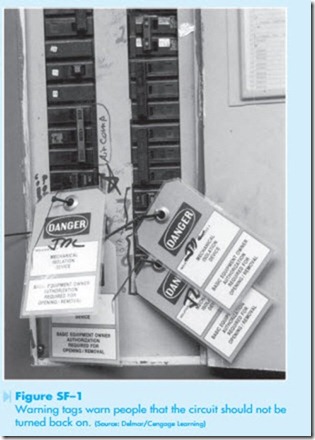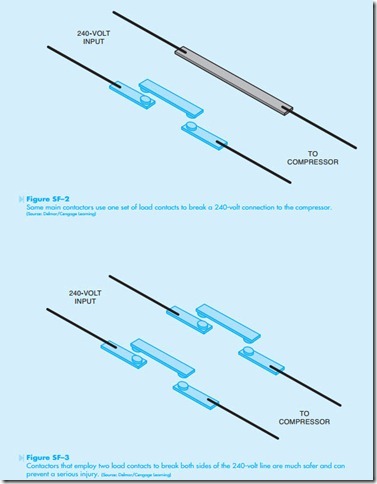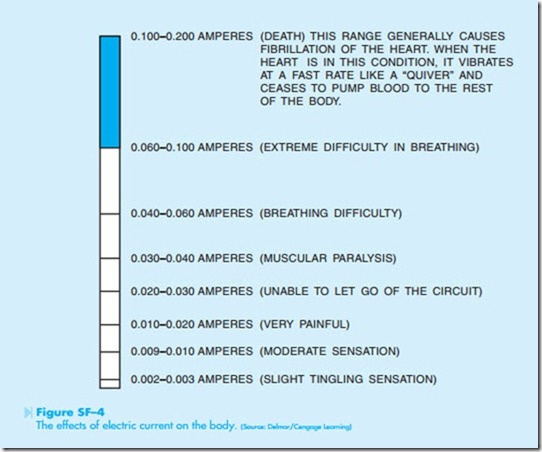The purpose of this textbook is to provide the air conditioning and refrigeration technician with knowledge of electricity. Electricity is an extremely powerful force and should never be treated in a careless manner. The air conditioning and refrigeration technician commonly works with voltages ranging from 24 volts to 480 volts. One mistake can lead to serious injury or death.
Never work on an energized circuit if it is possible to disconnect the power. When possible, use a three-step check to make certain that the power is turned off. The three-step check is as follows:
1. Test the meter on a known live circuit to make sure the meter is operating.
2. Test the circuit that is to be de-energized with the meter.
3. Test the meter on the known live circuit again to make certain that the meter is still operating.
Install a warning tag at the point of discon- nection to warn people not to restore power to the circuit, as shown in Figure SF–1.
GENERAL SAFETY RULES
Think
Of all the rules concerning safety, this one is proba- bly the most important: No amount of safeguarding or “idiot-proofing” a piece of equipment can protect a person as well as the person’s taking time to think before acting. Many technicians have been killed by supposedly “dead” circuits. Do not depend on circuit breakers, fuses, or someone else to open a circuit. Test it yourself before you touch it. If you are work- ing on high-voltage equipment, use insulated gloves and meter probes designed to be used on the voltage being tested. Your life is your own, so think before you touch something that can take it away.
Certain pieces of equipment can be especially hazardous if you are not aware of them. Some cen- tral air conditioning units use a main contactor that has only one set of contacts to disconnect a 240-volt circuit, as shown in Figure SF–2. The contactor operates on the principle that a complete circuit must exist for current to flow. If one line is broken or open, no current can flow to the compressor. The hazard lies in the fact that one of the 240-volt lines is still supplying power to the unit. If a techni- cian should touch the unbroken line and ground, a 120-volt circuit is completed through his body. Other contactors employ two load contacts to break the circuit to the compressor, as shown in Figure SF–3. This type of contactor is much safer and can prevent a serious injury.
Avoid Horseplay
Jokes and horseplay have a time and place, but the time and place are not when someone is working on an electric circuit or a piece of moving machinery. Do not be the cause of someone’s being injured or killed, and do not let someone else be the cause of you being injured or killed.
Do Not Work Alone
Work with someone else, especially when working in a hazardous location or on a live circuit. Have someone with you to turn off the power or give arti- ficial respiration or cardiopulmonary resuscitation (CPR). One of the effects of electrical shock is that it causes breathing difficulties and can cause the heart to go into fibrillation.
Work with One Hand When Possible
The worst case for electrical shock is when the current path is from one hand to the other. This path causes the current to pass directly through the heart. A person can survive a severe shock between the hand and one foot that would other- wise cause death if the current path were from one hand to the other.
Learn First Aid
Anyone working on electrical equipment should make an effort to learn first aid. Knowing first aid is especially important for anyone who must work with voltages above 50 volts. A knowledge of first aid and especially CPR may save your life or someone else’s.
Effects of Electric Current on the Body
Most people have heard that it is not the voltage that kills but the current. Although this is a true state- ment, do not be misled into thinking voltage cannot harm you. Voltage is the force that pushes the cur- rent though the circuit. Voltage can be compared to the pressure that pushes water through a pipe. The more pressure available, the greater the volume of water flowing through a pipe. Students often ask how much current will flow through the body at a particular voltage. There is no easy answer to this question. The amount of current that can flow at a particular voltage is determined by the resistance of the current path. Different people have different resistances. A body will have less resistance on a hot day when sweating because salt water is a very good conductor. What you ate and drank for lunch can have an effect on your body resistance. The length of the current path can affect the resistance. Is the current path between two hands or from one hand to one foot? All of these factors affect body resistance.
The chart in Figure SF–4 illustrates the effects of different amounts of current on the body. This chart is general and shows the effects on most people. Some people may have less tolerance to electricity, and others may have greater tolerance.
A current of 2 to 3 milliamperes will generally cause a slight tingling sensation. The tingling sensation will increase as current increases and becomes very noticeable at about 10 milliamperes. The tingling sensation is very painful at about 20 milliamperes. Currents between 20 and 30 mil- liamperes generally cause a person to seize the line and become unable to let go of the circuit. Currents between 30 and 40 milliamperes cause muscular paralysis, and currents between 40 and 60 milliamperes cause breathing difficulty. By the time the current increases to about 100 milliamperes, breathing is extremely difficult. Currents from 100 to 200 milliamperes generally cause death because the heart usually goes into fibrillation. Fibrillation is a condition in which the heart begins to “quiver” and the pumping action stops. Currents above 200 milliamperes generally cause the heart to squeeze shut. When the current is removed the heart will typically return to a normal pumping action. This is the principle of operation of a defibrillator. It is often said that 120 volts is the most dangerous voltage to work with. The reason is that 120 volts generally cause a current flow between 100 and 200 milliamperes through the bodies of most people. Large amounts of current can cause severe electrical burns. Electrical burns are usually very serious because the burn occurs on the inside of the body. The exterior of the body may not look seriously burned, but the inside may be severely burned.


